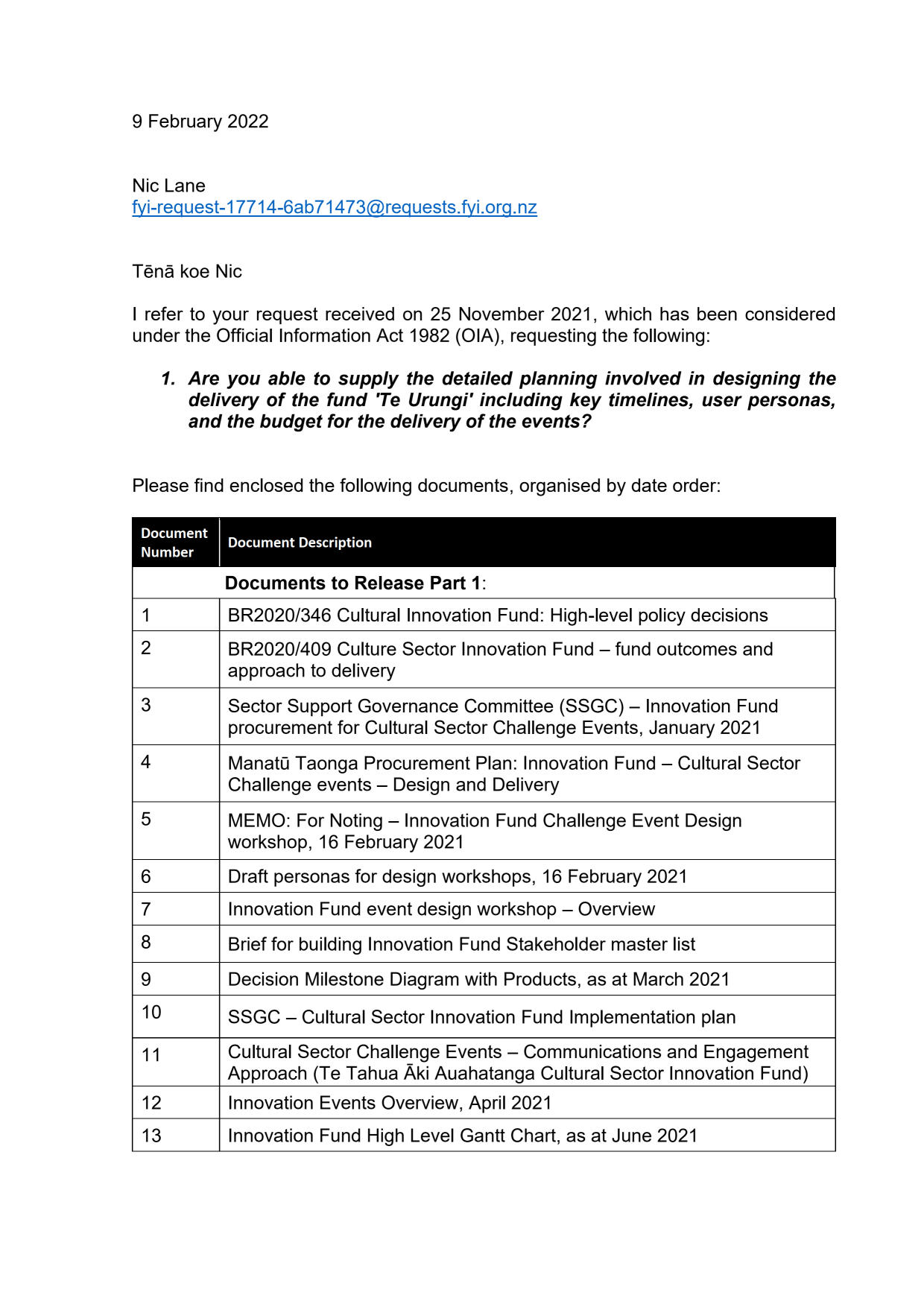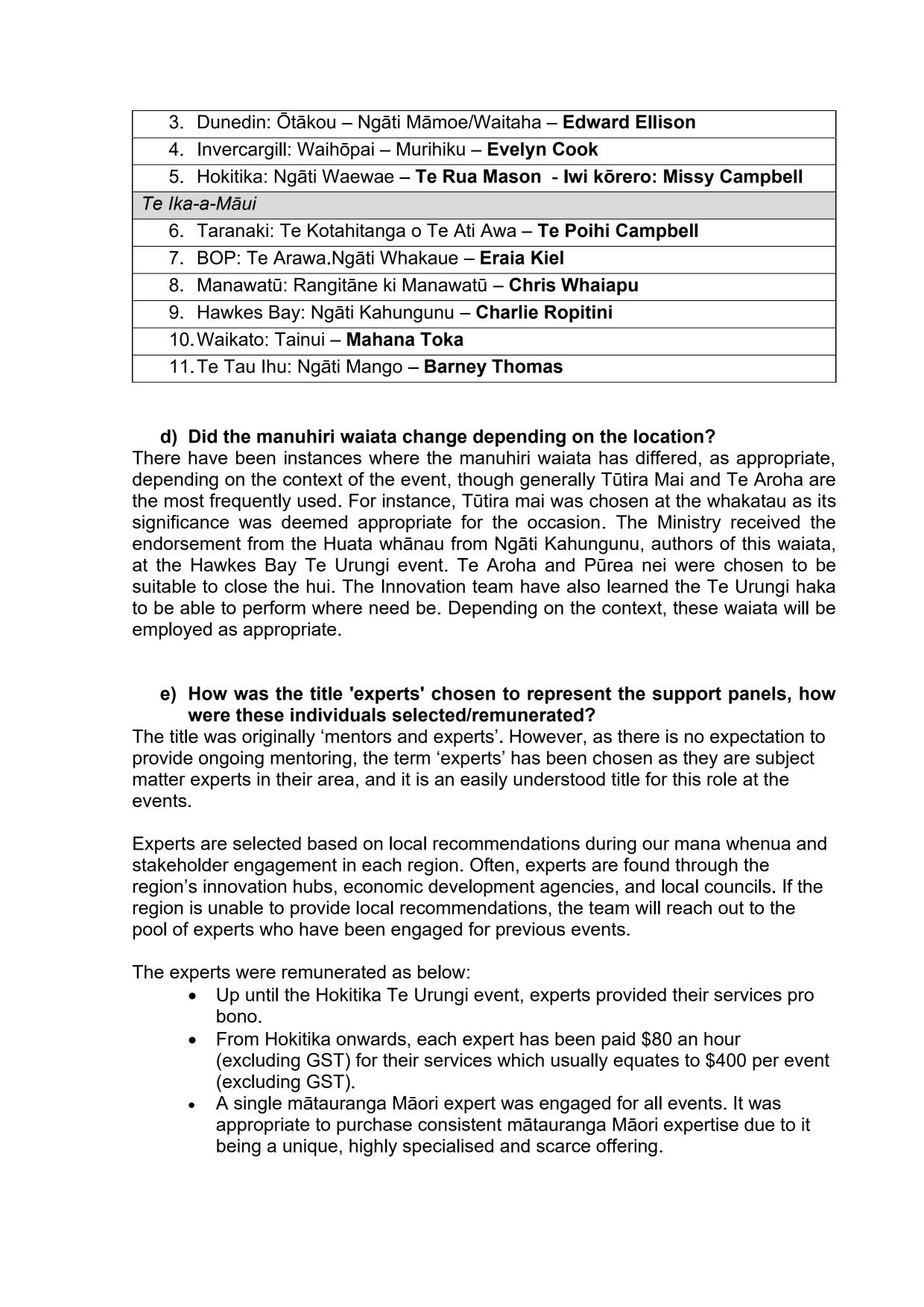
14
Innovation Fund Event and Notification Milestone Diagram, as at June
2021
15
Manatū Taonga Procurement Plan: Innovation Fund – Te Urungi Event
Management Disbursements and Facilitators Procurement Approach
Documents to Release Part 2: Timeline planning spreadsheet
I have decided to release the documents listed above, with a small amount of
information being withheld under section 9(2)(a) of the OIA – to protect the privacy of
natural persons.
Document 10, the Cultural Sector Innovation Fund Implementation Plan, reflects the
content and substance from a series of informal discussions and high-level workshops
which occurred between mid-January 2021 till the end of February 2021
.
Regarding the budget for the delivery of the events, please refer to Figure 1 below.
Maximum cost
Expected cost (average)
Total cost per event
$86,000
$64,000
Figure 1: Forecast budget for event delivery disbursements and facilitators, as at 27 July 2021
according to
Manatū Taonga Procurement Plan: Innovation Fund – Te Urungi Event Management
Disbursements and Facilitators Procurement Approach.
Please see below for responses to the rest of your questions.
a) What was the procurement process for selecting delivery partners?
A procurement plan was in place to purchase the design and delivery services for the
first eight Te Urungi events, released to you as Document 4, and expanded in
Document 15, in
Documents for Release Part 1. Please note, some details in these
plans are now out-of-date as the delivery of the fund was amended and refined as it
progressed, including transition to online delivery. We have not included mana whenua
as delivery partners in answering this question as they were engaged to provide
cultural services at the event. Additional facilitators/kaiāwhina were sourced from both
CreativeHQ and the Ministry, and thus are not considered a separate delivery partner.
CreativeHQ
The identified preferred provider, CreativeHQ, is part of the AoG collaborative Contract
Panel of Suppliers (Consultancy Services – Business Change). The preferred
approach was to direct source CreativeHQ given its national coverage and extensive
experience undertaking similar events (including with a number of government
agencies). A proposal was requested from them for the project.
Research was undertaken into other providers on the AoG Consultancy Services –
Business Change Panel to see if any other organisations have the same experience
and capability as CreativeHQ. This included discussions with other Ministries that have
undertaken similar events as well as with individuals that have participated in similar
events. Several providers were identified as having run similar events however the
references for CreativeHQ from Callaghan Innovation and MBIE suggested that


f) What design iterations have been made since the fund was first
implemented? How was feedback collected, including dates this was
requested from participants following the workshops? How was this
subsequently prioritised and can you able to please supply feedback in a
csv file with the names retracted?
Please refer to the below list for key design iterations made since the fund was first
implemented:
• Pre-event phone calls to all participants to confirm attendance (i.e., reduce
“no shows” at the event), enquire about any accessibility requirements, and
answer any questions they have about the event.
• Event Guide amended to include key information only. Innovation tools
removed and to be provided by kaiāwhina as relevant to participant needs.
• Expert sessions changed to 30 minute booked slots and additional experts
available (up to 8 per event).
• Blue-sky thinking exercise added to learn and understand more about the
sector’s priorities and common problems.
• Additional guidance and structure wrapped around the panel sessions,
including clarity around Chair and panel member roles and rotation of the
Chair role.
• Development of project plan guidance and a budget template for those
requesting project funding.
• Detailed kaiāwhina pack developed to support all kaiāwhina in their role.
This includes a consistent script to provide all teams.
• The online event format changed significantly after learnings from the first
online event, including multiple platforms tested and the most fit for
purpose used, clear communications prior to the event (including email,
phone call and text), tech rehearsal before every event, implementing a
test event so participants could check their technology set up is working, IT
helpline available throughout the event, development of online tikanga and
incorporating a networking session in the event agenda
Feedback is collected both through verbal discussion with participants at events and
more formally through an anonymous post-event survey. Survey results are shared
and reviewed by the Innovation team, with actions agreed where required. The team
also holds internal ‘retrospectives’ after every 1 – 3 events, where feedback is noted
and actions are agreed upon, where required.
In actioning design iterations as a result of feedback, there were some considerations
made, such as:
- Some non-negotiable matters indicated by the policy settings of the Fund that
could not be changed
- The need to maintain fairness and probity was emphasised so that the
experience and expectations remained consistent across events




